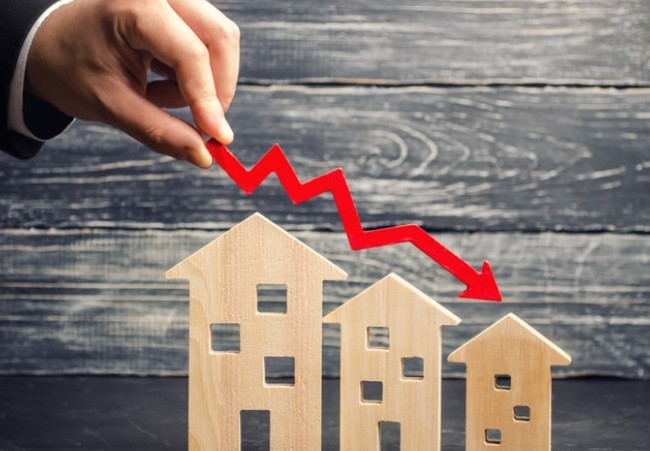Last two years have seen an increase in home loan outstanding of Rs 10 lakh crore: RBI data – ET RealEstate
NEW DELHI: According to RBI data on “Sectoral Deployment of Bank Credit,” credit outstanding to the housing industry increased by around Rs 10 lakh crore over the previous two fiscal years to reach a record Rs 27.23 lakh crore in March of this year.
This increase in outstanding home credit was ascribed by real estate and banking experts to pent-up demand and a robust rebound in the residential real estate market following the COVID outbreak.
The credit outstanding for housing (including priority sector housing) stood at Rs 27,22,720 crore in March 2024, up from Rs 19,88,532 crore in March 2023 and Rs 17,26,697 crore in March 2022, according to data from the Reserve Bank of India (RBI) on sectoral deployment of bank credit for March 2024.
Additionally, the data indicated that as of March 2024, the outstanding credit for commercial real estate was Rs 4,48,145 crore. March 2022 saw it at Rs 2,97,231 crore.
Numerous real estate advisors have reported large increases in both housing sales and prices throughout the last two fiscal years.
When contacted, Bank of Baroda Chief Economist Madan Sabnavis stated that the housing boom observed across all categories is the reason for the significant increase in home loans.
Sabnavis mentioned that the government’s initiative has specifically led to an increase in the affordable housing market.
“There was also some pent up demand for buying homes in the last two years after COVID which is getting reflected here,” he explained.
According to Sabnavis, the increase in housing loans would continue to be strong but would slow down to 15–25% because of the greater base.
Samir Jasuja, CEO and MD of PropEquity, a top provider of real estate data and analytics, commented on the RBI data and stated that the substantial increase in the number of homes launched and sold in the last two fiscal years is the main cause of the rise in the amount of housing loans outstanding.
“Major Tier-1 cities have seen high rates of price appreciation ranging from 50-100 per cent since FY 2021, which has influenced an increase in average loan size per property,” he stated.
Advt
Jasuja believes that as long as there is a high demand for residential real estate, the home loan market would continue to grow.
The Indian real estate market, which provides support to over 200 auxiliary industries such as steel and cement, has been seeing robust demand since 2022. Prior to this, the market had been stagnant for over ten years due to low sales and steady prices.
In addition to the disruptions brought about by the new real estate law, RERA, GST, and demonetisation, the real estate industry suffered from a lack of confidence as many developers failed to complete projects after collecting money from clients. Nonetheless, the industry recovered after COVID since the pandemic highlighted the value of owning a home again.
Industry insiders predict that by 2030, the sector will have crossed the $1 trillion mark.
Senior Vice President and Group Head at rating agency ICRA Karthik Srinivasan stated that the merger of Housing Development Finance Corporation Ltd (HDFC) with HDFC Bank, which became effective in July 2023, is the reason behind the notable increase in retail housing loans that banks deployed in FY’24.
“Mortgage saturation level is steadily rising in India (around 12 per cent as of March 2024; the amount of housing loans due as a proportion of GDP), but remains fairly lower than developed economies, implying significant room for growth,” said the economist.
In the near to medium term, ICRA anticipates that the trend will continue, with overall home finance growing by 12–14% yearly, helped by strong demand.
The demand for homes has increased to an unprecedented level over the last two years, especially in the wake of COVID, according to Aakash Ohri, Jr. Managing Director of DLF Home Developers.
This increase highlights how people’s views on homeownership have fundamentally changed and how important it is to have a place to call home more than ever. In addition to providing a haven for end users, residential real estate has become a desirable place to invest, the speaker claimed.
Ohri went on to say that favorable government policies, alluring financing choices, and the public’s growing ambitions toward homeownership are some of the reasons for the extraordinary rise in home loan advances.
According to Mohit Jain, Managing Director of Krisumi Corporation, purchasers are giving priority to designated workspaces and comfortable living rooms, and demand for large homes has genuinely surged.
“We are witnessing a surge in interest for properties with separate home offices and outdoor space features that were once regarded luxuries, but are now essential for the modern homeowner,” he stated.
According to Jain, there is still a very bright future for the property sector, which means that house loan growth will probably likewise continue to be robust.
According to realtors, the industry is most likely in the second or third year of a protracted up cycle. Real estate trade associations CREDAI and NAREDCO have been pleading with the government to raise the tax breaks on home loans in order to further stimulate the demand for housing. They are asking for an increase in the deduction allowed for interest paid on home loans from the existing Rs 2 lakh to Rs 5 lakh.



















































































